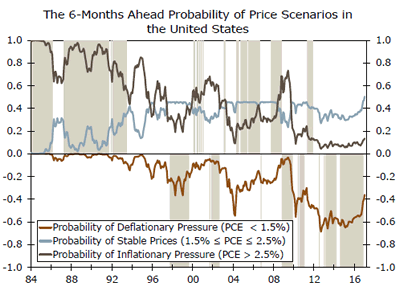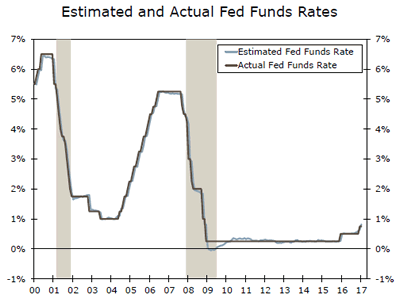U.S. Review
U.S. Housing Market Remains Solid
- In a light week of U.S. economic indicators, we focus on the housing market with existing home sales and the FHFA home price index released during the week. Existing home sales climbed more than expected in January, reaching a new-cycle high, but the solid pace will likely not be sustained in the coming months, as borrowing costs rise and inventories remain at a historically low level.
- Resulting from lean inventories, home prices remained firm in January, with the three-month moving average median home resale price up 6.0 percent year over year and FHFA home prices up 6.3 percent above year-ago levels.
U.S. Housing Market Takes Center Stage
During a light week of economic indicators, we received up-todate data on sales activity and pricing in the U.S. housing market. Following the first monthly contraction in five months in December, existing home sales rebounded 3.3 percent in January to a 5.69 million-unit rate, reaching the highest level in the postrecession period. Single-family sales rose 2.6 percent from an upwardly revised December print, and condos/co-ops grew 8.3 percent during the month.
The jump in sales activity in January is consistent with the surge in mortgage purchase applications in November, as would-be buyers rushed to lock-in rates following the election. On average it takes about two months to close on a home, according to the National Association of Realtors.
Existing home sales remained firm in 2016, registering a 3.8 percent increase relative to the previous year, but the pace intimates a moderation in activity from the strong 6.3 percent rate posted in 2015. Despite still-elevated consumer and builder sentiment, the pace of December existing sales activity likely will not be sustainable, as the low level of inventories continues to impede overall sales activity and the increase in mortgage rates makes it a bit more difficult for some prospective buyers to enter the market.
Total housing inventory now sits at 1.69 million, which is down 7.1 percent from a year earlier (top chart). Given the historically low level of inventories, home prices remained firm in January, with the three-month moving average median home resale price up 6.0 percent year over year (middle chart). Also released during the week, the FHFA home price index showed that prices grew 6.3 percent above year-ago levels.
One reason inventories remain low is the increase in housing rental unit conversions following the housing bust. Indeed, institutional buyers began purchasing distressed single-family homes for rentals, with initial holdings estimated at 180,000 (albeit a relatively small share on a national basis). The largest concentration of institutional holdings is in markets that saw the highest level of foreclosures during the downturn like Atlanta, Tampa, and Phoenix, according to company filings. In fact, these three markets combined comprise about one-third of total single-family institutional holdings.
With the homeownership rate for the under-35 age cohort (typically first-time home buyers) at a record-low level at just 34 percent, we expect the unprecedented high-share of renteroccupied households will remain firm in the coming years (bottom chart). Some first-time home buyers will also face hurdles from the recently reversed policy to reduce mortgage insurance premiums (MIPs) paid by borrowers on FHA-backed loans. In one of the first policy moves by the Trump Administration, FHA MIPs were increased from .60 percent (reduced in December) to .85 percent for most buyers. FHA purchase applications fell in January and February after a 6.7 percent increase in December.
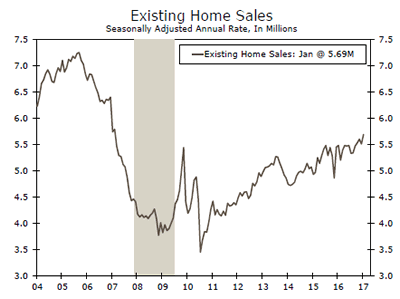
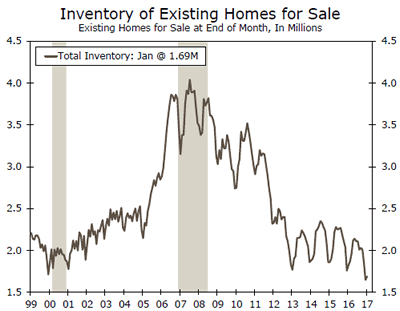
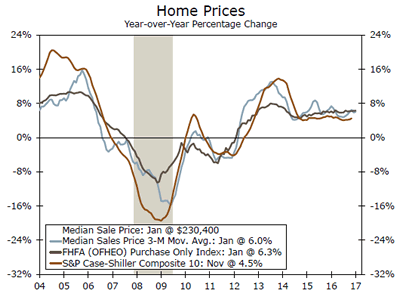
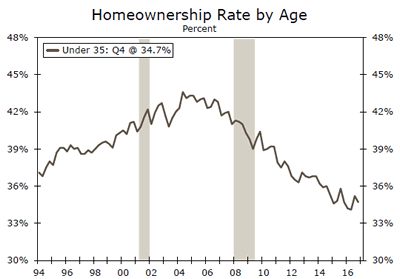
U.S. Outlook
Consumer Confidence • Tuesday
Consumer confidence slipped 1.5 points to start 2017, after surging to a cycle high in December. The drop was solely due to a decline in the expectations component, which fell 6.6 points on the month, while the present situation component rose. Despite the monthly decline, at a reading of 111.8, the index still points to an optimistic U.S. consumer.
Consumers’ assessment of current employment conditions has improved along with continued strengthening in the U.S. labor market. The proportion of consumers claiming jobs are "hard to get" has fallen meaningfully in line with the tightening of the U.S. labor market. We expect consumers to remain fairly optimistic over the course of the year, as continued job gains and income growth help propel sentiment and, in kind, consumer spending.
Previous: 111.8 Wells Fargo: 113.5 Consensus: 111.0
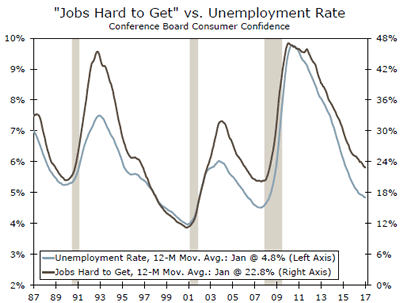
Personal Income & Spending • Wednesday
After a relatively weak start to Q4, personal consumption expenditures perked up 0.5 percent in December. Consumer spending was buoyed by a 1.4 percent pickup in purchases of durable goods, while spending on services rose a smaller 0.4 percent on the month.
On an inflation-adjusted basis, personal consumption expenditures rose 0.3 percent. Meanwhile, real disposable income inched up just 0.1 percent in December after a flat reading in November. With consumption outpacing income gains, the savings rate has fallen. The saving rate dropped to 5.4 percent in December from a rate of 5.6 percent in November and 6.1 percent a year ago.
We continue to expect personal consumption expenditures to support economic growth in the year ahead, as steady employment gains and real personal income growth support spending.
Previous: 0.3% Wells Fargo: 0.3% Consensus: 0.3% (Month-over-Month)
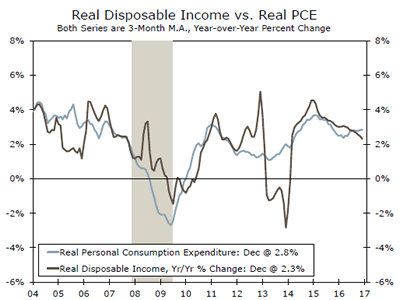
ISM Manufacturing • Wednesday
The ISM manufacturing index rose for the fifth consecutive month in January, climbing to 56.0. Gains were broad-based across index components, pointing to steady optimism among survey respondents. Nondefense capital goods orders ex-aircraft, our preferred gauge of near-term business fixed investment spending, rose 0.8 percent in December following a solid 1.5 percent reading in November. The production and new orders components also edged higher over the month. The employment component had perhaps the best upside surprise of the print, perking up to 56.1, the second-highest reading since the start of 2013. This was corroborated by the "hard" payrolls data, which reported a monthly gain of 5,000 manufacturing jobs. The steady improvement reported in this barometer for the factory sector suggests headwinds have eased relative to one year ago. We look for the ISM index to maintain its recent gains in February.
Previous: 56.0 Wells Fargo: 55.9 Consensus: 56.0
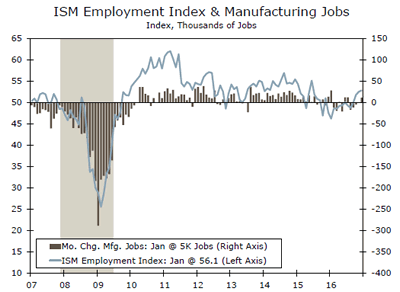
Global Review
Global Economy Continues to, Slowly, Improve.
- The Markit PMIs for the manufacturing and services sectors improved in February in the Eurozone and in Germany. Both manufacturing PMIs hit a cycle high, underscoring the improvement in this sector in the global economy.
- In South America, the Brazilian central bank lowered its Selic benchmark interest rate to 12.25 percent from 13.0 percent, and has brought interest rates down 200 bps since September of last year. We still see some more interest rates cuts in the coming months, as the rate of inflation has come back to the central bank’s target of 4.5 percent plus/minus 2 percentage points.
Global Economy Continues to, Slowly, Improve
The Eurozone Markit manufacturing PMI cycle continued its improvement in February to a high of 55.5 from a 55.2 reading in January in a sign that the improvement in global economic activity is alive and well. However, the manufacturing index was not the only index that improved, as the Markit services PMI also shot up to 55.6 from a previous reading of 53.7, also a cycle high.
We saw a similar situation in Germany with its Markit/BME manufacturing index hitting a high of 57.0 in February from 56.4 in January while the Markit services PMI also rose to 54.4 from a reading of 53.4 the previous month. Meanwhile, we saw further improvement in Germany’s IFO business climate index as well as in the expectations and current assessment IFO indices, which bodes well for the German economy going forward. At the same time Germany’s Gfk consumer confidence index dropped marginally, from 10.2 in February to 10.0 in March, but remained close to the cycle high of 10.2.
Meanwhile, Mexico released Q4 and full-year GDP growth rates from the supply side and the numbers showed an economy that continues to grow but growth is not even across the sectors. The economy grew by 2.3 percent during 2016, down from a growth rate of 2.6 percent the previous year. However, the industrial sector’s growth was down during the year, declining 0.4 percent and driven by the continuous collapse in the mining sector. However, the manufacturing sector, albeit still weak, was able to post a growth rate of 1.3 percent during the year.
We remain concerned for Mexican economic growth this year due to the current political environment, both north and south of the border and the potential effects this new environment may continue to have in the currency, the rate of inflation, and in expectations regarding the future. Thus, we are still forecasting a mild recession for this year. We will be able to make a better call on this year’s performance after the release of Q1 2017 results as we may see the full effect of the depreciation of the currency, the increase in interest rates and the strong increase in inflation, which will all take a bite of economic activity this year.
In South America, the Brazilian central bank reduced its Selic benchmark interest rate by 75 bps this week to take the rate to 12.25 percent. The Selic rate is down 200 bps since September of last year, as inflation has already returned to the central bank’s target of 4.5 percent plus/minus two percentage points after recording a rate of 10.7 percent in January of last year. January 2017’s year-over-year rate of inflation was 5.4 percent. Furthermore, our expectation is that inflation dynamics will continue to improve during the first half of this year so the probability of more rate cuts by the Brazilian central bank remains in place, at least in the near term. These actions by the Brazilian central bank will help the country leave behind two years of GDP declines, and although we are not expecting a strong economic rebound this year. The economy will finally add to global GDP after two consecutive years of contraction.
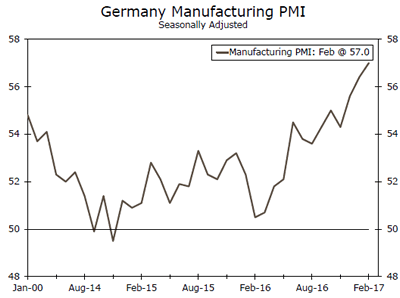
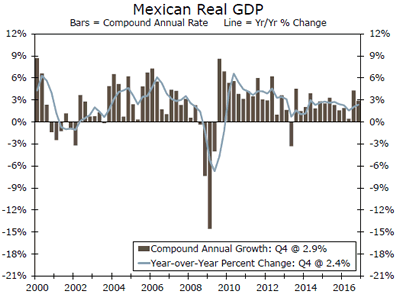
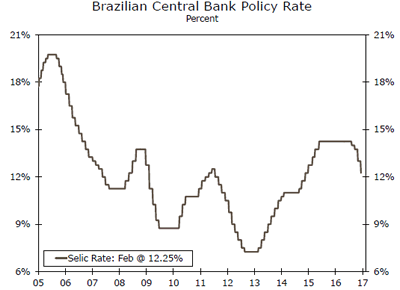
Global Outlook
Australian GDP • Wednesday
Australia’s export-oriented economy has been under pressure in recent years as slower growth in China (Australia’s top export market) has weighed on growth in Australia.
For the most part in recent years, resilient domestic demand has offset the weakness in trade. In Q3 2016 however, steep declines in business investment spending pushed overall GDP growth into negative territory. In our view, this kept the potential for further rate cuts from Australia’s Reserve Bank. More recently, the RBA has signaled a willingness to remain on hold, citing strength in the Aussie labor market.
Next week, we will get a sense of how the Australian economy finished out 2016 when Q4 GDP figures print on Wednesday.
Previous: -1.8% Consensus: 1.9% (QoQ, CAGR)
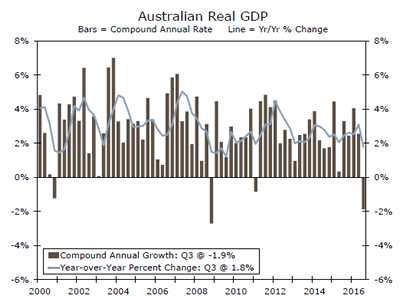
Canadian GDP • Thursday
Canadian GDP growth picked up to annualized pace of 3.5 percent in Q3 2016. The fastest quarterly growth rate in two years had a lot to do with a bounce-back in oil exports after wildfires held back exports in the prior quarter. Still, it was not all exports, as consumer spending also grew at a steady clip and inventories helped lift growth as well.
Thursday of next week brings a first look at Canadian GDP growth for Q4. Manufacturing shipments increased in two out of three months during the period and the same can be said of retail sales. Together, that suggests domestic demand may have held up well during the period. While trade figures may not benefit from the same low-base-effects that flattered the headline GDP number in Q3, Canada did return to a modest trade surplus in Q4.
Previous: 3.5% Wells Fargo: 2.0% Consensus: 2.0% (QoQ, CAGR)
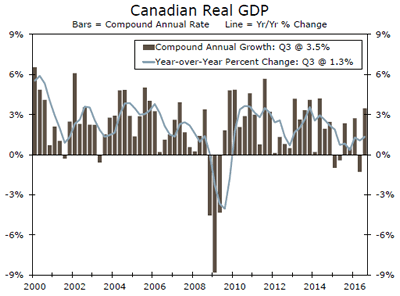
Japanese CPI • Friday
In September 2016 the Bank of Japan (BoJ) added to its already accommodative monetary policy by introducing yield curve control and a pledge to overshoot its 2.0 percent inflation target.
The yield curve control essentially entails conducting the BoJ’s purchases of Japanese government bonds (JGB), with a goal of achieve a 10-year JGB yield of 0.0 percent. The CPI overshoot is a bit more straight-forward with its pledge to overshoot the 2.0 percent target and "stay above the target in a stable manner."
The yield on the 10 year JGB has been range-bound near zero since September, but CPI inflation-while somewhat higher-has a long way to go to even hitting its target and obviously further to go to exceed it. Through December, CPI inflation was just 0.3 percent. Next Friday, we will get a look at January CPI figures for Japan.
Previous: 0.3% Wells Fargo: 0.3% Consensus: 0.3% (Year-over-Year)
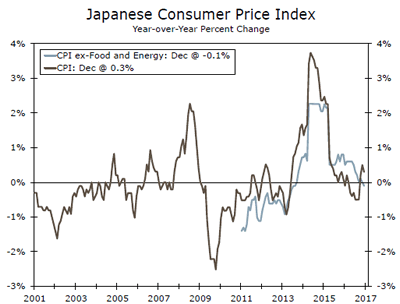
Point of View
Interest Rate Watch
Capital Flows and Refinance Risk.
Recent trends in capital flows may signal a change in sentiment and thereby, upside risk to benchmark Treasury rates in the year ahead.
As illustrated in the top graph, there has been a recent dip in foreign private purchases of U.S. securities and while this has happened in the past, we are concerned that with the uptrend in Treasury debt issuance ahead, a decline in market demand would pit an upward bias to Treasury rates going forward. This bias would be reinforced by a Federal Reserve focused on raising the benchmark federal funds rate in response to rising inflation numbers.
CBO Baseline: More Debt
Under the current budget baseline, CBO projects a steady rise in U.S. debt held by the public as a percentage of GDP (middle graph). This baseline does not reflect the effect of fiscal stimulus either in the form of tax cuts or infrastructure/defense spending. Over the next 10 years, CBO projects federal revenues and outlays to average 18.1 percent of GDP and 22.0 percent of GDP, respectively. The result is a large and growing budget gap. This gap stems mostly from growing outlays for the major health programs, Social Security and net interest expenses. Our projected federal budget deficit for the current 2017 fiscal year climbs to $650 billion or 3.4 percent of GDP and then $950 billion or 4.7 percent of GDP for fiscal year 2018. The secular shift to mandatory spending and net interest expense is illustrated in the bottom graph.
Supply and Demand Matters
This projected increase in Treasury deficits/debt issuance over the next two years stands in contrast to the decline in foreign private purchases we have seen, as shown in the top graph. This pattern creates a refinancing risk over the next few years. In the past, the failure to fund refinancing at a profitable pace has been the focus of many credit squeezes and economic downturns. We are alert to this risk as we move forward.
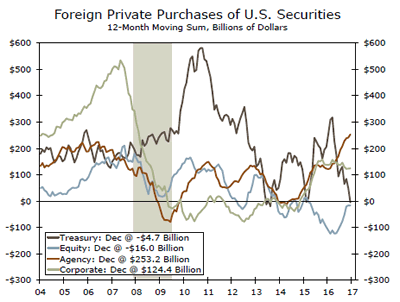
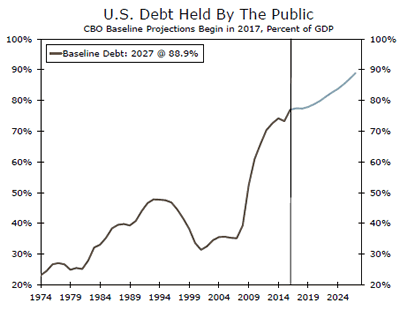
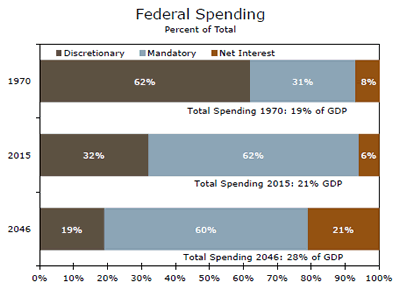
Credit Market Insights
Expanding Household Debt
According to the Federal Reserve’s quarterly report on debt and credit, household debt balances increased significantly to $12.58 trillion in the Q4 of 2016 and now remains just 0.8 percent below its Q3 2008 peak of $12.68 trillion. Mortgage balances, which comprise the largest share of household debt, increased $130 billion from Q3 2016. Moreover, all categories of non-housing debt balances grew in Q4, with a $22 billion jump in auto loan balances, a $32 billion increase in credit card balances and a $31 billion increase in student loan balances.
Despite the growing debt burden, delinquency rates were relatively stable in Q4 2016. Roughly 200,000 consumers had a bankruptcy notation amended to their credit reports in Q4 2016, 4 percent fewer than in the same quarter last year. Mortgage delinquencies were also roughly stable, with 1.6 percent of mortgage balances 90 or more days delinquent at the end of Q4 2016. Likewise, credit card delinquency rates for 90 days or more were unchanged at 7.1 percent. However, auto loan delinquency rates continued to deteriorate, with 3.8 percent of auto loan balances 90 or more days delinquent on Dec. 31, representing a 0.2 percentage point increase from the previous quarter.
Finally the number of credit inquiries within six months, declined from the previous quarter to 171 million.
Topic of the Week
How Many Rate Hikes in 2017?
Among financial market participants, the general consensus is that the Federal Open Market Committee (FOMC) will continue raising its target for the fed funds rate in the near future. Whether the FOMC can shake its recent string of projecting multiple rate hikes and delivering just one remains an open question.
The answer will likely depend on the state of the labor market and inflation expectations. In our past work, we have provided an econometric model to estimate the near-term path of the fed funds rate (Persistent Sightings of Low-Inflation Zombies—A Threat to Market Pricing? available upon request). The model utilizes probabilities of inflationary, disinflationary and stable price pressures, top chart, along with a measure of the state of the labor market to estimate the path of the fed funds rate, bottom chart.
Our model results suggest a possibility of more than one rate hike in 2017. Why? Since June 2011, the probability of disinflationary price pressure was higher than the other two price scenarios. The persistent inflation readings below the Fed’s target of two percent inflation were considered to be one major reason (along with other factors) for only one rate hike per year for 2015/2016.
Today, according to our model, the inflation outlook for the near term has changed from disinflation to stable prices. That is, since November 2016, the probability of stable prices has been higher than the other two price scenarios and the model suggests a rate hike in the next six months. The persistent below two percent inflation rate has been a major cause of the slow pace of monetary policy normalization, and our model indicates there has been a change in the inflation outlook and thereby the potential for more than one rate hike in 2017. We will continue to monitor our model and will update our readers accordingly.
